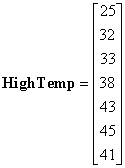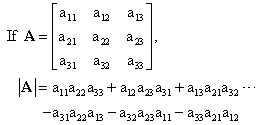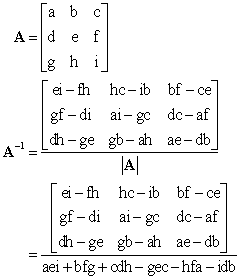
This page is meant to be a brief review of the notation and elementary operations associated with arrays. For our purposes vectors will be one dimensional arrays, and matrices will be two dimensional arrays. If you feel comfortable with arrays, feel free to skip it.
Contents
Vectors are an efficient notational method for representing lists of numbers. A typical vector might represent the high temperature every day for a week. Such a vector would have seven elements and could be written as a row vector (a single row),

or as a column vector (a single column),

Note, that I will use bold letters when referring to the entire vector (or matrix). In both cases above, the HighTemp vector has seven elements, representing Sunday through Saturday. To access the individual elements in the array we use an index. For example, the temperature Sunday would be accessed as HighTemp(1), and is equal to 25. Likewise HighTemp(4)=38 is Wednesday's high temperature.
A matrix (singular of matrices) is for our purposes a series of numbers listed in two dimensions. As an example, consider high temperatures collected over a 28 day period (4 weeks). We could write the matrix as a single list 28 elements long, or as a collection of numbers (a matrix) that has 4 rows and 7 columns.

Now we need two indices to represent the numbers, one for the row, and one for the column. For example the high temperature during the 2nd week, on the 3rd day of that week, is HighTemp(2,3) and is equal to 45. Note that the index for the row comes first.
In general a matrix consisting of m×n elements can be arranged in m rows and n columns, yielding an m×n (read m by n) matrix, which we'll call A.

The symbol aij represents the number in the ith row and the jth column. Note that a vector is the special case of a matrix, where there is only one row or column - In this case, the second subscript is dropped.
For the ensuing discussion assume we have three matrices
![]()
Two matrices are equal if they are the same size, and corresponding elements are equal. For example, A=B, but A≠C.
Two matrices can be added if they are the same size. Their sum is given by a third matrix whose elements are the sum of the corresponding elements being added.of the two arrays. In other words, if D=A+C then dij=aij+cij.
![]()
Note that matrix addition is commutative, X+Y=X+Y.
We could also write the matrix with rows and columns interchanged. This is referred to as taking the "transpose" of the matrix. We'll denote the transpose with a single quote, '. In other words, if D=A', then dij=aji.
![]()
A matrix need not be square in order to take its transpose. The transpose of a column vector is a row vector, and vice versa.
A matrix can be multiplied by a scalar (a scalar is a single number) by multiplying each element of the array by that number. For example if D=2·A, then dij=2·aij.
![]()
Two matrices, A and C can be multiplied together in the order A·C if and only if the number of columns in A equals the number of rows in C. If D=A·C, then dij is the element obtained by multiplying the row vector represented by the ith row of A by the column vector represented by the jth column of C. For arrays A and C with n columns and rows, respectively, we get:
![]()
For example, if D=A·C, using the matrices given previously
![]()
Note that in general A·C≠C·A. In this case
![]()
Expressed another way in words. if D=A.C, then the element in D located at row i and column j is given by the sum of the product of the elements in row i of A and the elements in column j of C.
A row vector can be multiplied by a column vector, in that order, if and only if the have the same number of elements. If
 ,
then
,
then

The determinant of a square matrix A is a scalar defined by
![]()
where Cik is referred to as the cofactor of aik, and
![]()
where Mik is the minor of aik. Mik is the determinant of the matrix that remains of A after the ith row and jth column are deleted. In general it can be computationally very difficult to calculate determinants. If the matrix has more than 3 rows and columns, you should use a computer or calculator to help you. For 2×2 or 3×3 matrices there is are shortcuts (that don't work for larger matrices).

This is simply the product of the terms identified by the blue arrow (down and to the right) minus the product of the red arrow (up and to the right).

A similar rule applies to the 3×3 matrix (but not larger matrices). The only complication is that the arrows wrap around the matrix from the right side to the left.


The identity matrix is a square matrix that has ones along the main diagonal and zeros elsewhere. The 2×2 identity matrix is shown below.
![]()
The identity matrix has the special property that A·I=I·A=A.
If the matrix A has an inverse G, we write G=A-1, and G·A=A·G=I. Note that some matrices don't have inverses.

You can check for yourself that A·A-1=I.
The inverse can be calculated as follows
![]()
where

and Cik is the cofactor of aij. In general the inverse of a matrix is computationally very difficult to calculate. If the matrix is greater than 2×2, use a calculator or a software package such as MatLab. For a 2×2 matrix the inverse may be written as:

For a 3×3 matrix the inverse may be written as:

Consider a linear system of algebraic equations with n equations and n unknowns:

In these equations, aij and bi are constants, and the unknowns are xi. We can rewrite the equations as:
![]()
where

We can find all the unknowns in the vector x by doing a few simple matrix manipulations. If we premultiply both sides of the matrix equation by the inverse of the A matrix we get:

which is our solution.
Note: This discussion has assumed that all the equations are independent, i.e. that you can't form one of the equations from combinations of other equations.
Consider the system of 3 equations and 3 unknowns:

Clearly,

Note: we didn't calculate A-1 directly, but don't need to if we use a calculator or computer.
>> A=[2 3 -1;-1 2 3;0 1 2]
A =
2 3 -1
-1 2 3
0 1 2
>> b=[-1 9 5]'
b =
-1
9
5
>> x=inv(A)*b
x =
-1
1
2
The eigenvalues are the diagonal of the "d" matrix; λ1=-1, λ2=-2. The eigenvectors are the columns of the "v" matrix. Note that MatLab chose different values for v1,1, etc..., but that the ratio of v1,1 to v1,2 and the ratio of v2,1 to v2,2 are the same as our solution. (MatLab chooses the values such that the sum of the squares of the elements of the eigenvector equals unity).
© Copyright 2005 to 2019 Erik Cheever This page may be freely used for educational purposes.
Erik Cheever Department of Engineering Swarthmore College